
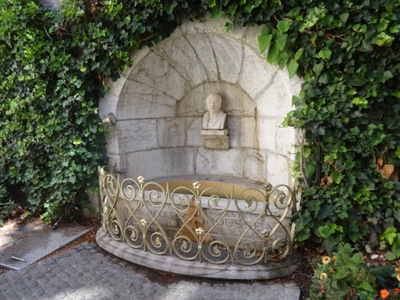 As we were staying in an Ibis, we got another "Market Breakfast," pretty much like all the others.
As we were staying in an Ibis, we got another "Market Breakfast," pretty much like all the others.Tuesday, 19 July 2016, Annecy to Lyon
Written 25 August 2016

 As we were staying in an Ibis, we got another "Market Breakfast," pretty much like all the others.
As we were staying in an Ibis, we got another "Market Breakfast," pretty much like all the others.
Here's the view out my hotel window. This is the same pool (of the river Thiou) where we saw the mergansers (right in the middle) and the family of swans just out of sight behind the willow tree at the right-hand edge. Historically, the low, canopied platform at the water's edge on the far side would have been a wash-house, where local housewife gathered to do their laundry. Now, it would make a good boat landing, except that there's nowhere to go—it's trapped between two weirs.
First thing after breakfast we walked over to the Office de Tourisme to assemble for our walking tour. This one wasn't as good as some, but we were still given way more information than I could absorb. The guide brought along her granddaughter (ca. 6 years old), who was remarkably patient although obviously bored. Apparently their ordinary day care fell through. Fortunately, one of the tour participants brought along her son, who was also bored and more vocal about it. Once the two kids hit is off, they amused each other and were less trouble to the rest of us.
When Jean Jacques Rousseau (1712–1778), francophone philosopher, writer, and composer, got fed up, at age 15, with living in his native Geneva, he ran away and walked to Annecy. (It's only about 40 km; even now, when folks from Annecy drive "into the city" to go shopping, they mean Geneva, which is the closest larger burg). Shortly after he arrived, he met and fell completely in love with a 29-year old woman who lived there. She was separated from her husband and apparently intimate with the steward of her house. She waited until Rousseau was 20 before taking him as her lover as well, a three-way arrangement he is said to have found confusing. But despite his later travels and involvement with other women, he always considered her the great love of his life (he idolized her and even called her "mama"), referring to her in his writing as "Leonore," although that wasn't her real name. He arranged that, after his death, a little gilded railing should always enclose the spot where he first met her, and the photo at the right is it. The railing is still kept gilded. Sweet.
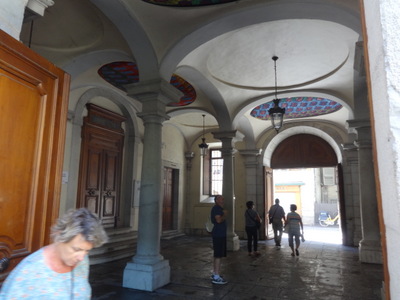
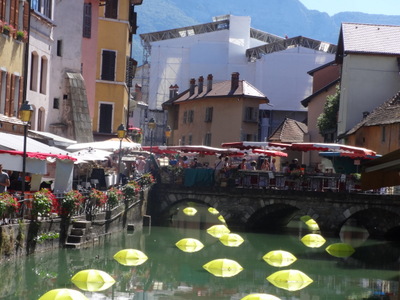 The little railing is in a courtyard behind the what, at the time, was a row of houses, including the one were Leonore lived. They were replaced by the bishop's palace, which has now been repurposed again and is occupied by the city police station and an academy of music. As we left the courtyard, we walked through this decorative passageway, which separates the two.
The little railing is in a courtyard behind the what, at the time, was a row of houses, including the one were Leonore lived. They were replaced by the bishop's palace, which has now been repurposed again and is occupied by the city police station and an academy of music. As we left the courtyard, we walked through this decorative passageway, which separates the two.
On the other side was another section of canal decorated with more yellow umbrellas. The guide explained that they are appropros of a city festival that encourages people to go out shopping, strolling, and otherwise enjoying themselves at night. She also revealed, alas, that the floating segments of marsh were there for the same reason and would not be kept permanently.
On the bridge and the street along the canal a market was in progress. We got to walk through it as part of the tour.
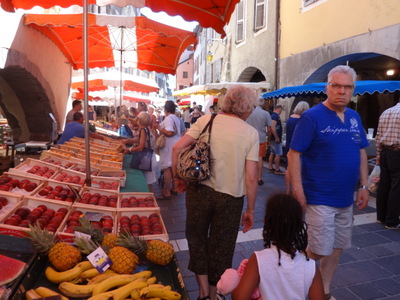
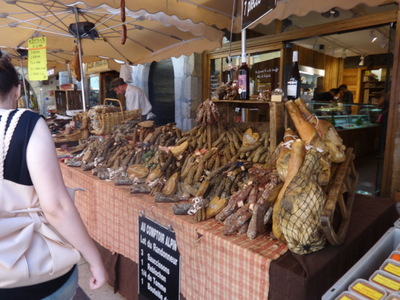 In the photo at the left, the lady in the white blouse is our guide, and the child behind her is the granddaughter, clutching a stuffed toy. Periodically, she would have her grandmother put the stuffed toy in her tote bag and get out a different one, but she always had one with her.
In the photo at the left, the lady in the white blouse is our guide, and the child behind her is the granddaughter, clutching a stuffed toy. Periodically, she would have her grandmother put the stuffed toy in her tote bag and get out a different one, but she always had one with her.
Written 26 August 2016
The display in the photo at the right is of dry sausages, all sizes, shapes, and flavors. A few hams are stacked at the right-hand end of the counter. The black sign hanging from the table advertises the "Hiker Pack"—three dry sausages, a Reblochon, 1/4 of a tomme, and a bottle of . . . (presumably wine). The yellow sign hanging below the canopy advertises a different assortment, comprising six items, for 33 euros.
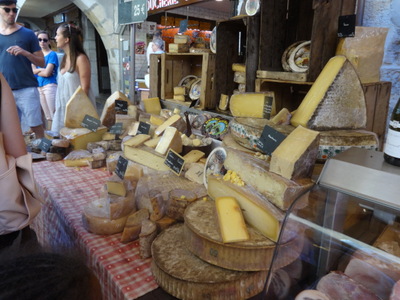
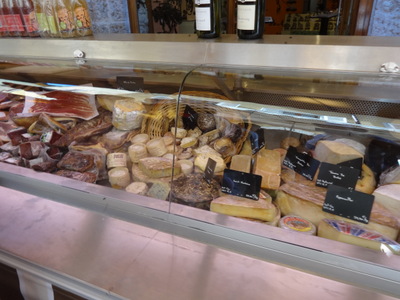 These two photos are of the two ends of a cheese display. At the left are the drier, more durable cheese, displayed at room temperature—Beaufort, tomme de Savoie, tomme de brebis (brebis means "ewe"), Abondance, Comté, even (at the upper right) Parmesan. Here and there amongst the piles are little heaps of cheese cubes for sampling.
These two photos are of the two ends of a cheese display. At the left are the drier, more durable cheese, displayed at room temperature—Beaufort, tomme de Savoie, tomme de brebis (brebis means "ewe"), Abondance, Comté, even (at the upper right) Parmesan. Here and there amongst the piles are little heaps of cheese cubes for sampling.
At the right, in the refrigerated/humidified case together with ham, dried beef, and other cold cuts, are the softer, younger ones—, Brillat-Savarin, cow's-milk blue, Saint Nectaire, cremeux de Bourgogne, etc.
Our guide provided, as usual, more information that I could absorb, but here's what I could capture in my recorded notes.
Greater Annecy includes about 150,000 people. Very little of the city survives from the Medieval period. Most is about 400 years old, dating from the 16th century, and is built of calcareous dressed stone. The city's symbol is the lake trout, and she showed us a stylized trout worked into the wrought-iron railing of the old (not the current) town hall.What we toured was "vieux Annecy"—"old Annecy"—the historic section of the city proper. Across the lake, a village has adopted the name Annecy-le-Vieux, "Annecy the Old." The result is constant confusion among tourists, who go to the village, confusing it with old Annecy! Coincidentally, Annecy-le-Vieux has become France's equivalent of Silicon Valley; when I first discovered webcams, the very first one I viewed was located in a computer shop there!
The old city is grouped around four churches: St. Peter's cathedral, Notre Dame, (with a guilded figure of the virgin on top), St. Maurice, and St. Francois (de Sales) (I think I got those right). In 1460, Savoie became a comté (a county, ruled by a count). Later it became a duchy (ruled by a duke), and in the 18th century, the duchy became a kingdom, Piedmont-Sardaigne, which extended over the alps into what is now Italy and all the way south to Sardinia (in the deal, Sardinia was acquired in exchance from Sicily). At that point, the capital moved from Chambéry (which we passed through about three quaters of the way from Grenoble to Le Bourget-du-Lac) to Turin, on the other side of the Alps.Only in 1860 did Savoie (and Nice, which was also part of Piedmont-Sardaigne) become part of France. Savoie already spoke French.
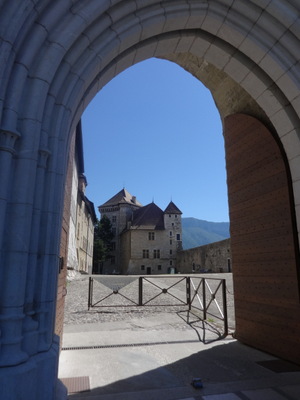
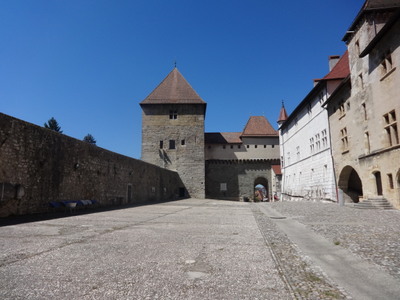 The tour also included the exterior and the courtyard of the city's château—not one of the decorative ones on the shores of the lake, but a real fortified pile at the top of a hill in the old city.
The tour also included the exterior and the courtyard of the city's château—not one of the decorative ones on the shores of the lake, but a real fortified pile at the top of a hill in the old city.
Here's the view in through the castle gate and (at the right) the view back the other way from the far end of the courtyard. The original tower—the red-roofed square to the left of the gate)—is the oldest part, built by, and serving as residence for, the Counts of Geneva in the 12th century. Its walls are over 4 m thick. Those of other parts range from Walls of the castle 2 to 4 m thick; the walls are 8 m high and the towers 10 m high.
The castle was added to for a couple of hundred years, then abandoned in the 17th century. It served as barrack during WWII. In 1953, the town bought it and installed a museum (which we didn't take time to visit after the tour).
The most recent part of the castle is the "chemin de rond," the walkway around the tops of the walls, which was built in the 19th century.
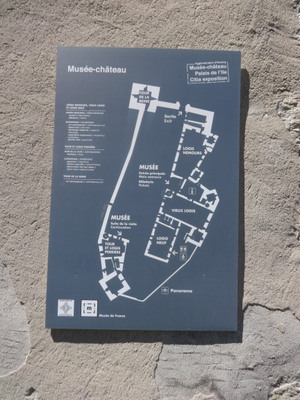
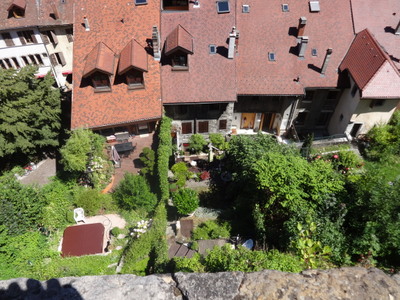 At the left here is a diagram of the layout of the château. The gate we entered by is at the top, and the original tower at the top left. The thin line at the bottom right represents a waist-height wall over which we had a panoramic view over the old town and the lake.
At the left here is a diagram of the layout of the château. The gate we entered by is at the top, and the original tower at the top left. The thin line at the bottom right represents a waist-height wall over which we had a panoramic view over the old town and the lake.
The tower over the buildings along the right-hand edge of the diagram, which has apparently been widely copied, has two clocks, one facing the courtyard and the other out over the town. The town paid for the one it could see, but by arrangement, was maintained by the chanoines of the castle.
At the right is the view straight down over the wall. I'm sure the people who live in those houses and keep those lovely decks and gardens (I think the brown square at the lower left is the cover of a hot tub or jacuzzi) get rather tired of tourists like us gawking down into their back yards, and probably dropping candy wrappers, and the occasional camera, over the wall.
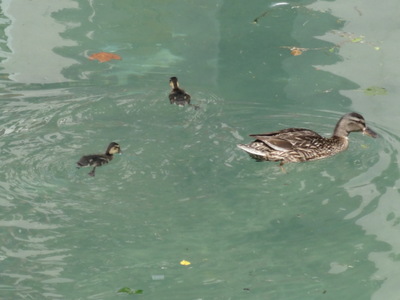
 By the end of the tour, it was lunch time, so we went in search of an interesting restaurant. Back down by the canals, where these ducks were dabbling among the yellow umbrellas, we found one whose name, alas, I did not record.
By the end of the tour, it was lunch time, so we went in search of an interesting restaurant. Back down by the canals, where these ducks were dabbling among the yellow umbrellas, we found one whose name, alas, I did not record.
As we studied the menus, they brought us this dish of green olive tapenade. It must have been a slightly upscale place, as an amuse-bouche is unusual in the sort of lunch place we usually frequent.

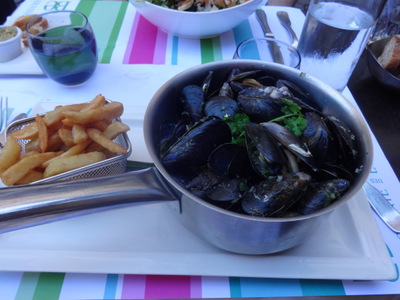 David chose a salad showered with flakes of cheese and topped with bacon (unknown in this crisp-fried slice form in France just a few years ago but becoming more and more common) and a large, thin slice of raw beet.
David chose a salad showered with flakes of cheese and topped with bacon (unknown in this crisp-fried slice form in France just a few years ago but becoming more and more common) and a large, thin slice of raw beet.
I took the opportunity to have mussels, which are not a specialty of Savoie and therefore haven't been common on menus. They came, as usual, with fries and were excellent.
Written 28 August 2016
Then it was back to the hotel to pick up our luggage. The elevator directly from the lobby to the garage was out of order, so we had to wheel our things around the block to go in the outside entrance. Bbut we extricated the car without difficulty, using a little card the hotel gave us that conferred a discount on the fee, and headed for Lyon. Again it was freeway all the way, and we retraced our route back down around the southern end of the Lac du Bourget, passing between Cambéry and Le Bourget.
All was smooth sailing until we approached the turn toward the Lyon airport, where we planned to turn in the car—the illuminated signs along the highway that are used to announce traffic jams, accidents ahead, etc., were flashing that the freeway was entirely closed ahead, in both directions! Fortunately, the closure was just beyond our turn, so we were able to head for the airport as planned, although traffic was heavy because, of course, everybody else on the road had to take that exit as well.
We followed the airport signage to the rental car return (turning off the GPS, which was still trying to take us to the terminal) and ruefully explained that we'd scraped the side of the car. Our credit car includes insurance on rental cars, so we weren't worried about the cost, but every time this happens, it means weeks and months of paperwork. The clerk said she'd already spotted the damage as we drove in but was surprised when we led her around to the rear passenger side. The scrape she had spotted was on the front driver's side! Apparently somebody had backed into us while the car was parked somewhere. Our first reaction was, well, rats, but then we actually felt better. We would have had to go through the paperwork even if we hadn't scraped the car, so "our" scrape had done no harm!
We had planned to walk to take the rental-agency shuttle to the terminal to find a taxi, but the nice clerk just called over there and had a taxi come pick us up at her office. The ride to our hotel was some what round-about, and again traffic was heavy on the little roads we took, because of the freeway closure. We got the story from the taxi driver, though. It was the absolute action-movie classic—a fuel tanker truck had overturned, spilled its contents, and caught fire. The driver got away, but the fire melted the roadway in both directions, so clearly that freeway wouldn't be back in commission for a couple of days.
Fortunately, a little research revealed that our hotel was far enough north to make the northern loop to the airport a reasonable alternative, so we weren't held up two days later when we flew out.
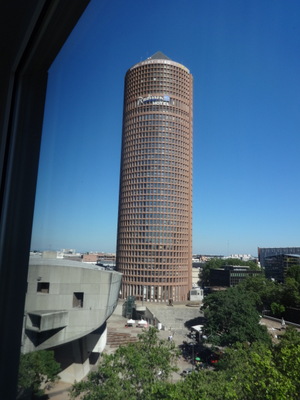
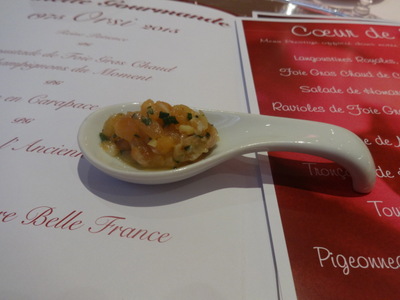 I chose our Ibis Hotel in Lyon for its proximity to two good restaurants and to the city's main train station (where taxis would be abundant and we could even catch the subway to the airport if we needed to). A bonus of its location is that it's directly across the street from Lyon's main covered market, which operates daily!
I chose our Ibis Hotel in Lyon for its proximity to two good restaurants and to the city's main train station (where taxis would be abundant and we could even catch the subway to the airport if we needed to). A bonus of its location is that it's directly across the street from Lyon's main covered market, which operates daily!
The left-hand image is the view out my hotel-room window—Lyon's famous "crayon," i.e., "pencil," so named for its cylindrical shape and pointed conical roof. It has a Radisson hotel in it and is part of the complex that includes the train station and a huge shopping mall. The last time we were here, we ate at a restaurant on its top floor. Because it was shaped like a semicircle, surrounding the buildings central core, and because it was so high up, the restaurant was called the Arc en Ciel, the rainbow. It has closed, alas, and been replaced with something much less interesting.
So we dined instead at Pierre Orsi, named for the chef, who has been cooking at that spot for over 40 years. At the right is the first amuse-bouche, a spoonful of tartare of salmon marinated with ginger.
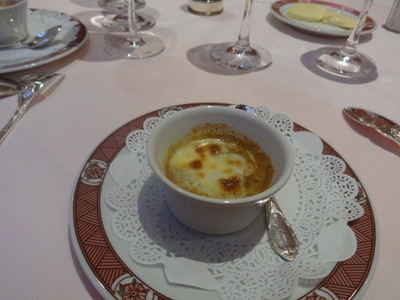
 We chose a menu called the "Dînette Gourmande." The second amouse-bouche, shown here at the left was a little casserole of veal sweatbreads and mushrooms in a cream sauce, which I found distinctly odd because we had just ordered a menu of which the main course was sweatbreads. The salmon tartare also appeared elsewhere on the menu. French restaurants usually assiduously avoid repeating like that. The amuse-bouche is usually something that appears nowhere on the menu, let alone in the menu the table has just ordered.
We chose a menu called the "Dînette Gourmande." The second amouse-bouche, shown here at the left was a little casserole of veal sweatbreads and mushrooms in a cream sauce, which I found distinctly odd because we had just ordered a menu of which the main course was sweatbreads. The salmon tartare also appeared elsewhere on the menu. French restaurants usually assiduously avoid repeating like that. The amuse-bouche is usually something that appears nowhere on the menu, let alone in the menu the table has just ordered.
The first listed course was sautéed foie gras on a bed of the "mushrooms of the moment," in this case mostly shiitake and oyster mushrooms.

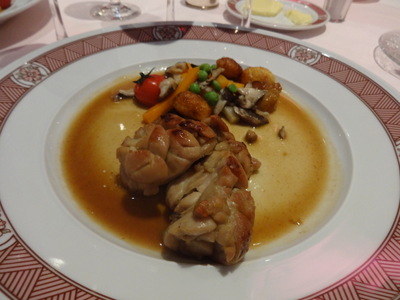 The second course was lobster, cooked, shelled, stuffed back into its shell, and broiled under a cheese cream sauce. Very good.
The second course was lobster, cooked, shelled, stuffed back into its shell, and broiled under a cheese cream sauce. Very good.
The main course was roasted whole veal sweetbreads, served with a little heap of mixed fresh vegetables and "real jus." Yummy. Even David thought so.
The single waiter (the place wasn't very big) was working his way around the room offering to take photos of the diners with their cameras. While we waited for the main course, he came to us, took a photo of us, then took several more, tilting the camera first 45° to the left then 45° right, then taking a video, in which he panned around the whole room, encouraging the other diners to wave as he passed them. Unfortunately, that one didn't come out.
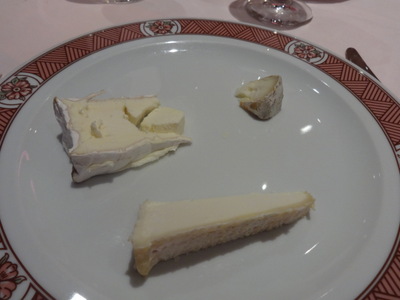
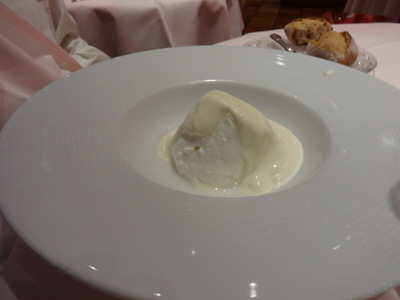 The cheese course was supposed to be a set assortment of three, but when the time came, the waiter brought the whole trolley over. I chose picodon d'Ardeche (the tiny one, a chevre), Brillat-Savarin (a very rich mild cow's milk), and Pouligny St. Pierre (the long skinny one, a favorite chevre of mine from the valley of the Loire).
The cheese course was supposed to be a set assortment of three, but when the time came, the waiter brought the whole trolley over. I chose picodon d'Ardeche (the tiny one, a chevre), Brillat-Savarin (a very rich mild cow's milk), and Pouligny St. Pierre (the long skinny one, a favorite chevre of mine from the valley of the Loire).
David once again chose fromage blanc with cream and sugar.
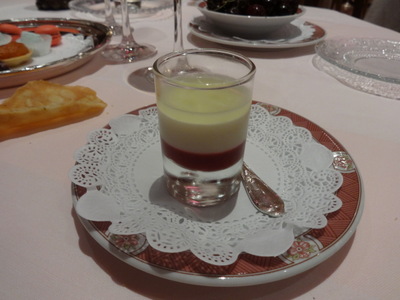
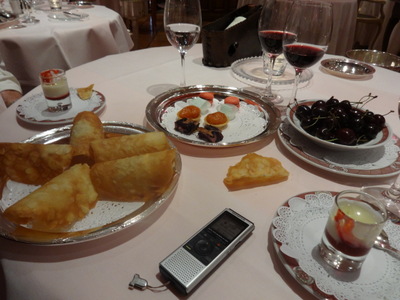 The predessert was a sort of parfait of, from the top down, lime jelly, licorice custard, and red fruit compote. Delicious.
The predessert was a sort of parfait of, from the top down, lime jelly, licorice custard, and red fruit compote. Delicious.
The mignardises were, for some reason, served before the dessert: tuile cookies (so called because they are made in the shape of roof tiles), a bowl of fresh black cherries, and a plate of tiny squares of blueberry cake, little tarts each containing a single stewed apricot half, cubes of pale-green marshmallow, and bright pink raspberry filled macaroons.
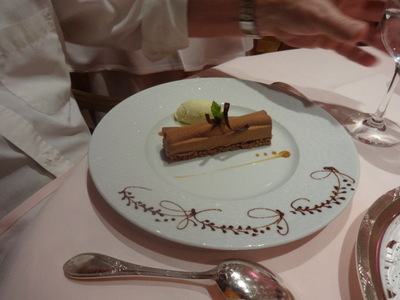
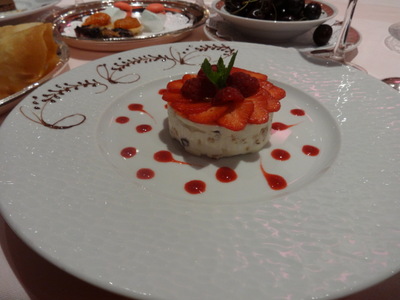 For the actual dessert, we got to choose from the menu. David picked a "sablé au caramel"—a sort of caramel ganache served on top of a crumbly shortbread cookie.
For the actual dessert, we got to choose from the menu. David picked a "sablé au caramel"—a sort of caramel ganache served on top of a crumbly shortbread cookie.
I chose nougat glacé (i.e., nougat-flavored ice cream filled with bits of nuts and glacé fruit) shingled on top with fresh strawberries and raspberries. The decorations around the edge of the plates were hand-piped with chocolate syrup.
 Finally, here's the best photo the waiter got of us at the table—the one where we are well illuminated and right-side-up.
Finally, here's the best photo the waiter got of us at the table—the one where we are well illuminated and right-side-up.
I questioned the waiter closely to make certain that this restaurant had really been here, in this very building for 40 years, because I had the definite feeling that we'd been there before. The place is on a very distinctive little square, and I even knew that we had walked there from the other direction the last time (from a different hotel) via the Passage Casanove, which I would see next to the restaurant. So when we left, I insisted we walk around the corner and look at it from the original direction, and there was the explanation. The restaurant we were at last time was called Casanove, and was right next door, separated from Pierre Orsi only by the pedestrian passage (photo at http://www.bio.fsu.edu/~thistle/blog11/11-06-20.html; the pink wall at the right is part of Pierre Orsi). I knew we'd been there before!